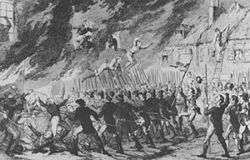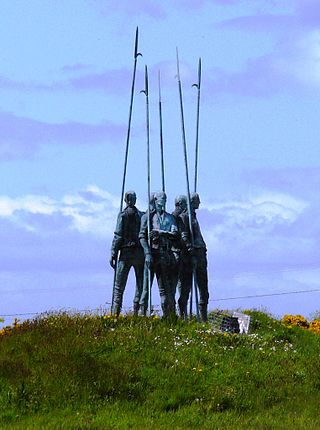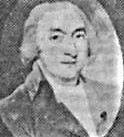
The Irish Rebellion of 1798 was a popular insurrection against the British Crown in what was then the separate, but subordinate, Kingdom of Ireland. The main organising force was the Society of United Irishmen. First formed in Belfast by Presbyterians opposed to the landed Anglican establishment, the Society, despairing of reform, sought to secure a republic through a revolutionary union with the country's Catholic majority. The grievances of a rack-rented tenantry drove recruitment.

Ballynahinch is a town in County Down, Northern Ireland. It had a population of 6,164 people in the 2021 census.

Saintfield is a village and civil parish in County Down, Northern Ireland. It is about halfway between Belfast and Downpatrick on the A7 road. It had a population of 3,588 in the 2021 Census, made up mostly of commuters working in both south and central Belfast, which is about 18 km away. The population of the surrounding countryside is mostly involved in farming.

The Battle of Prosperous was a military engagement between British Crown forces and United Irishmen rebels during the Irish Rebellion of 1798 in the town of Prosperous, County Kildare. Prosperous was founded by Sir Robert Brooke in 1780 as a village for processing cotton produced in the Americas. When a rebellion spearheaded by the United Irishmen broke out against British rule in Ireland, rebel forces led by John Esmonde made plans to capture Prosperous. Esmonde had 200 rebels under his command, while Prosperous was garrisoned by elements of the Royal Cork City Militia under the command of Captain Richard Swayne reinforced by detachments of a Welsh mounted fencible regiment, the Ancient British Regiment of Fencible Cavalry Dragoons, numbering 150 men in all.

The Battle of Tara Hill was fought on the evening of 26 May 1798 between British forces and Irish rebels involved in the Irish Rebellion of 1798, resulting in a heavy defeat for the rebels and the end of the rebellion in County Meath.

The second Battle of Arklow took place during the Irish Rebellion of 1798 on 9 June when a force of United Irishmen from Wexford, estimated at 10,000 strong, launched an assault into County Wicklow, on the British-held town of Arklow, in an attempt to spread the rebellion into Wicklow and to threaten the capital of Dublin.
The Battle of Tubberneering took place during the Wexford Rebellion fought on 4 June 1798 between Crown forces and United Irish insurgents, at Tubberneering south of Gorey in the north of County Wexford. The rebels ambushed and routed the British.
The Battle of Antrim was fought on 7 June 1798, in County Antrim, Ireland during the Irish Rebellion of 1798 between British troops and Irish insurgents led by Henry Joy McCracken. The British won the battle, beating off a rebel attack on Antrim town following the arrival of reinforcements but the county governor, John O'Neill, 1st Viscount O'Neill, was fatally wounded.
The battle of Ovidstown was a military engagement between British Crown forces and United Irishmen rebels during the Irish Rebellion of 1798 near the town of Kilcock, County Kildare. Despite the initial failures experienced by the United Irishmen in County Kildare during the first months of the rebellion, the consolidation of government forces in the town of Naas and the priority given by the Dublin Castle administration to suppress the Wexford Rebellion in County Wexford meant that much of the county remained in rebel hands since the outbreak of the rebellion. Towns such as Prosperous and Clane were in rebel hands, while towns such as Maynooth, Kilcock and Kildare had been attacked and briefly occupied by the rebels. By 19 June, however, neighbouring County Meath had been judged sufficiently pacified to allow for government forces to be dispatched from that county into Kildare to recapture rebel-held territory.
The Dunlavin Green executions was summary execution of 36 suspected United Irishmen rebels in County Wicklow, Ireland by the Irish Yeomanry shortly after the outbreak of the rebellion of 1798. There are several accounts of the events, recorded at differing times and differing in detail.

John Murphy was an Irish Roman Catholic priest of the Roman Catholic Diocese of Ferns, who is mainly remembered for his central role in the Irish Rebellion of 1798 in County Wexford, which is sometimes known as the Wexford Rebellion. He led the rebels to one of their initial victories over a government militia at Oulart Hill, and in the following weeks became one of the rebellion's main leaders.
Events from the year 1798 in Ireland.
The Battle of the Harrow took place on 26 May 1798 and was the first clash of the Irish Rebellion of 1798 in County Wexford. It was fought between government forces and United Irishmen insurgents under the leadership of a local priest, John Murphy who had mobilized following reports of atrocities by the yeomanry during the rebellion led by the United Irishmen revolutionary organisation.

The Wexford Rebellion refers to the events of the Irish Rebellion of 1798 in County Wexford. From 27 May until 21 June 1798, Society of United Irishmen rebels revolted against British rule in the county, engaging in multiple confrontations with Crown forces. The most successful and destructive rising in all the counties of Ireland, United Irishmen rebels experienced a number of early successes in the county despite being seen as a relatively loyal county by the Dublin Castle administration due to a series of military victories. However, the tide soon turned against the United Irishmen in Wexford as Crown forces poured into the region, engaging in a brutal counterinsurgency which indiscriminately targeted suspected rebels and eventually suppressed all rebel activities in the county.

Elizabeth "Betsy" Gray, is a folkloric figure in the annals of 1798 Rebellion in Ireland. Ballads, poems and popular histories celebrate her presence in the ranks of the United Irishmen, and her death, on 12 June 1798 at the Battle of Ballynahinch. Contemporary records are unable to confirm the tale that has been told in all its detail, but they do point to the role of women in supporting the insurrection, including as combatants in the field. Contesting ownership of her memory, in 1898 local unionists disrupted Irish nationalist centenary commemorations and destroyed her grave marker.

The Battle of Saintfield was a short but bloody clash in County Down, Northern Ireland. The battle was the first major conflict of the Irish Rebellion of 1798 in Down. The battle took place on Saturday, 9 June 1798.
Henry Munro was a United Irishman born in Lisburn, County Down, who in 1798 commanded rebel forces, the United Army of Down, at the Battle of Ballynahinch.

The Battle of the Big Cross was a military engagement of the Irish Rebellion of 1798 between a force of United Irishmen rebels and a column of government troops. It was fought on 19 June 1798 on a spot on the Shannonvale-Ballinascarty road known locally as the "Big Cross", approximately four miles east of Clonakilty in West Cork. It was the only battle fought in the rebellion in County Cork.
The Battle of Rathangan was a military engagement between the forces of the British Crown and the United Irishmen during the 1798 rebellion.

Thomas Ledlie Birch (1754–1828) was a Presbyterian minister and radical democrat in the Kingdom of Ireland. Forced into American exile following the suppression of the 1798 rebellion, he wrote A Letter from An Irish Emigrant (1799).












